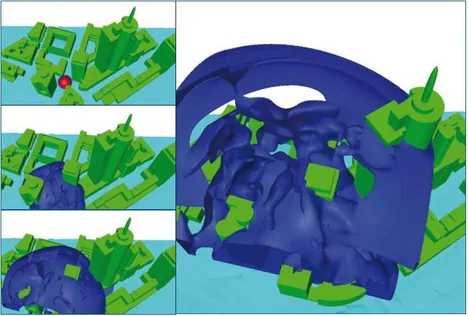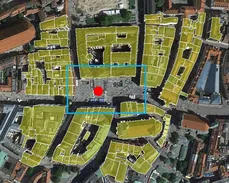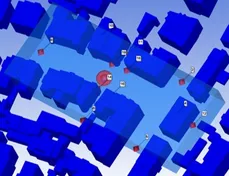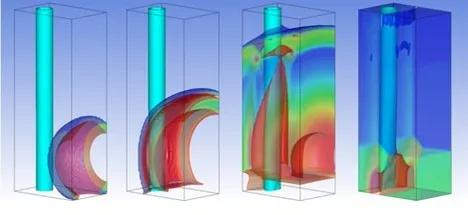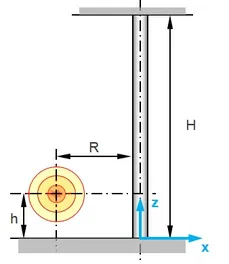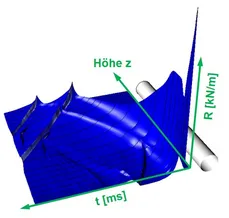Overview
Ongoing research projects:
Completed research projects:
- ZIM-project ZF4291802RU8 - MobiSE: a flexible mobile civil protection system for public places and events
- DFG ME 3296/3-1 - Fundamental evaluation of the connection formation of optimized composite column structures under highly dynamic action by near detonations
- KMU-innovativ - DETORBA Method for analysis of detonation effects in urban areas
- CIPS4000002079 - MAPEX Probabilistic damage-mapping development tools for urban critical infrastructures against terrorists attacks
MobiSE - a flexible mobile civil protection system for public places and events
- ZIM-project ZF4291802RU8
- Project period: 2019 - 2021
The aim of the project was to develop an easily transportable and manageable mobile system to protect the civilian population at events and in public places against attacks by motor vehicles. The system has a modular design and is therefore flexible to use and expand, and thus adaptable to a wide variety of local conditions. Pedestrians and cyclists, as well as wheelchairs and baby carriages, can easily pass through the protection system - both in regular operation and in the event of a possible escape or panic. The individual parts are made of high-strength steel materials, with cast materials being used for the floor beams. This ensures high toughness even at low temperatures and increases the protective effect. The structure is built by plugging the individual modules together and lining them up. This creates a barrier that prevents intruding vehicles from passing through. The system can be stored in a space-saving manner and, due to the low individual weight of the components, assembly can easily be carried out by two people. Functionality has been confirmed by a certification test.
Methods for analysing detonation effects in urban areas - Construction of technology models for optimization of detonation simulation
- Project sponsor: BMBF Federal Ministry of Education and Research, Project 13N12665 DETORBA
- Project Management Agency: VDI Technology Centre, Düsseldorf
- Project period:
- Project partner: CADFEM GmbH, virutalcitySystems GmbH, Dynardo GmbH, Institute for Photogrammetry, University of Stuttgart
Modern simulation methods allow an automated and realistic representation of complex city models for mechanical simulations. The aim of the project is to develop methods to simulate and analyse terrorist-motivated bomb attacks in urban areas with a previously unattainable level of accuracy. For the first time, modern simulation methods are combined with latest and most powerful methods of discrete three-dimensional city modelling to realistically represent detonation effects. This enables a systematic investigation of exposed urban areas based on high-resolution three-dimensional urban models. The application areas of the methods are risk assessment and damage analysis of infrastructure, urban planning, dimensioning of structures and support of rescue forces in emergency situations. The topic of aerial bombs since World War-II, which has not lost any of its topicality, was also addressed. In the event of incidents such as those in Munich-Schwabing and Worms, the procedures will enable a better assessment of the situation.
Tools for probabilistic damage assessment of critical urban infrastructure objects in terror threat situations
- Project MAPEX HOME/2011/CIPS/AG/4000002079 (Eurpean Commissions DG Home Affairs)
- Project period:
- Project partner: TECNALIA RESEARCH & INNOVATION,Spain; D‘APPOLONIA S.P.A., Italy
Methods for probabilistic damage assessment of urban infrastructure objects. The objective of MAPEX is to develop methods for probabilistic damage assessment for evaluation, analysis and enhancement of the safety level of critical urban infrastructures in the event of terrorist-motivated detonations. To this purpose, the urban environment, building geometry and construction were considered along with human response to the impact of a blast wave. The MAPEX research approach is based on threat assessment, simplified engineering models and state-of-the-art simulation methods. The project aims towards contribution to a more effective prevention, preparedness and consequence management of terrorist threats in complex urban scenarios with critical infrastructures, from a social and economic perspective.
Fundamental evaluation of the connection formation of optimized composite column structures under highly dynamic action by near detonations
- DFG-Project: DFG ME 3296/3-1
- Project period:
- Project partner:
Analysis of fundamental load-bearing behaviour of highly efficient composite column structures under detonation effects. The research project is in the field of explosion protection of structures and is intended to contributing to an increase the component resistance of column structures in steel-concrete composite construction under variable effects from nearby detonations. Composite column construction, when defined boundary conditions are adhered to, enable explosion resistance to the nearby detonations which is many times greater than that of pure steel or reinforced concrete cross-sections. Peripheral first floor columns were considered, used as primary load-bearing members of supporting structures in building construction and were particularly exposed to terrorist attacks. System’s influence on the complex dynamic load-bearing behaviour were fundamentally clarified in this research project and the associated failure mechanisms were identified.
Optimization of column structures under near-detonation effects. The direct influence of bearing and connection compliance and its optimization potential for column resistance has not yet been satisfactorily clarified and was fundamentally evaluated within the scope of this research project because the component response is significantly influenced by the bearing and connection design. In addition, for the highly loaded areas at the base of the column, it is possible to realize specific compliance by adapting bearing designs from structural protection. To clarify the issues, the investigations based on a parameterized model of the column system. By simulating the detonation in the air space and the transmission of the pressure wave load via different coupling methods to the continuum of the support system, the complex interactions were considered and the general influences between the parameters could be fundamentally clarified. The research project resulted from the doctoral thesis of Dr.-Ing. Stefan Trometer.
Increasing the component resistance of primary support members when exposed to explosions
- Project sponsor: Association of Friends of the Technical University of Munich
- Project period:
- Project partner:
The question of how the Western world should counter terror can certainly not be solved by optimizing structures alone but the work within this research project can be the contribution of civil engineering and especially of the Technical University of Munich. Funding from the Bund der Freunde secured our intensive efforts in this area and closed the gap to subsequent third-party funding from the German Research Foundation (DFG). The goal of maintaining the explosion protection research area and the special competencies at the Technical University of Munich was achieved.
